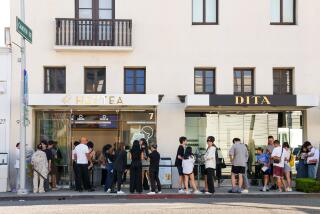Earl Grey, as American as Duke Ellington
- Share via
IT’S TEA TIME. Nearly half the U.S. population drinks tea in some form; iced tea accounts for 85% of consumption. Tea sales are booming -- from $1.8 billion in 1990 to more than $6 billion in 2005, according to the Tea Assn. of the USA. Even Starbucks offers tea-based frappuccinos.
Americans’ newfound enthusiasm for tea may strike some people as strange. An important step on the road to independence was, after all, the ritual shunning of tea that took place at the Boston Tea Party in 1773. As a result, notes the website of the tea firm Twinings, “for generations of Americans, tea has had a faintly unpatriotic association.” So does the recent rise of tea mean that Americans are turning over a new leaf?
“Tea in all of its myriad forms is hot and going to get even hotter,” declares a report from the Sage Group, a market research firm. Aging baby boomers are attracted by its health benefits -- tea is arguably one of the most widely used medicinal substances -- and its use as a social drink. Consumers also are paying more attention to the origin and quality of their foodstuffs, which has boosted sales of specialty teas.
As to the question of patriotism, the history of the United States’ relationship with tea is more complex than you might gather from the schoolbook version of the Boston Tea Party. That tale has the colonists switching to coffee overnight to protest the British imposition of a tax on tea -- and has Americans preferring coffee ever since. In fact, several of the organizers were tea smugglers whose livelihoods were under threat because the British East India Co. planned to dump surplus tea on the U.S. market at a knocked-down price. The rejection of tea was motivated not just by patriotism but by self-interest too.
And although tea imported by way of Britain was indeed spurned during the ensuing Revolutionary War, the colonists’ enthusiasm for the drink was undimmed, prompting them to go to great trouble to find local alternatives. Some made “liberty tea” from four-leaved loosestrife; others drank “balm tea” made from ribwort, currant leaves and sage. A small quantity of real tea was also covertly traded, often labeled as tobacco. But as soon as the war ended, the supply of legal tea began to flow again.
Ten years after the Boston Tea Party, tea was still far more popular in the new United States than coffee, which only took the lead in the mid-19th century. Coffee’s popularity in the U.S. grew after the duty on imports was abolished in 1832, making it more affordable. A duty on coffee was briefly reintroduced during the Civil War, but was abolished again in 1872. “America now admits coffee free of duty, and the increase in consumption has been enormous,” noted the Illustrated London News that year.
Meanwhile, tea’s popularity declined as the proportion of immigrants coming from tea-drinking Britain diminished in favor of settlers from coffee-loving continental Europe. It was economics and demographics, not patriotism, that enabled coffee to push tea aside.
So the notion that coffee is a patriotic drink, and that tea is somehow un-American, is simply wrong. Indeed, iced tea seems to have originated in the South during the 19th century as a nonalcoholic variation of punch and became popular at the 1904 World’s Fair in St. Louis.
So, the next time you drink tea, whether a delicate specialty blend, a ready-to-drink brew from a plastic bottle or a cool iced tea on a sweltering summer’s afternoon, rest assured that there is nothing unpatriotic about it at all.
More to Read
Inside the business of entertainment
The Wide Shot brings you news, analysis and insights on everything from streaming wars to production — and what it all means for the future.
You may occasionally receive promotional content from the Los Angeles Times.










